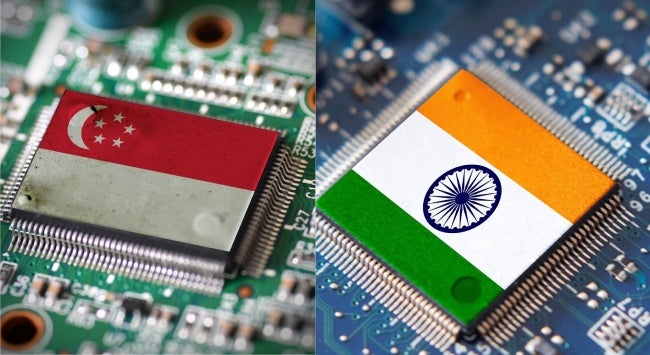Developing an India-Singapore Semiconductor Ecosystem
Karthik Nachiappan, Mriganika Singh Tanwar
20 November 2025Summary
An India-Singapore semiconductor partnership not only accelerates India’s push towards greater autonomy in chip manufacturing but positions Singapore as a key strategic partner in Asia’s largest emerging market, mutually reinforcing their semiconductor ambitions.
India and Singapore are building a semiconductor partnership. Semiconductors are essential components that power electronic devices, driving economic, scientific and military advancements. Semiconductors are also referred to as integrated circuits (ICs) or microchips, made primarily from silicon, gallium and germanium. The development of these chips, however, also involves various rare earth elements to make high-technology consumer goods like computer hard drives, mobile phones, electric vehicles and monitors, among others. The global demand for semiconductors continues to grow, with the market expected to reach US$1 trillion (S$1.31 trillion) by 2030. The production of semiconductors is closely tied to complex supply chains, and their distribution is associated with disproportionate capabilities across countries globally.
India
In 2021, the Indian government launched the India Semiconductor Mission (ISM) to build a full-stack semiconductor ecosystem. The ISM is driven by three major considerations: build semiconductor manufacturing, reduce import dependence on China and develop a semiconductor value chain. Recognising the important role of startups to scale innovation in India’s digital economy, the government has extended design infrastructure support to 278 academic institutions and 72 startups. In July 2025, the Ministry of Electronics and Information Technology approved 23 chip design projects, ranging from startups, micro, small and medium enterprises to academic institutions, primarily on applications such as surveillance systems, smart meters, networking equipment and microprocessor intellectual property (IP) cores. Through these initiatives, India is aiming to secure its position in the global semiconductor value chain. Promoting greater public-private as well as international collaboration has also opened up avenues for technology innovation, high-value job creation and increased participation in critical sectors such as automotive, telecom and industrial electronics.
Singapore
Singapore has established itself as a global node in the semiconductor supply chain since 1969. It has emerged as the preferred destination for multinational semiconductor firms, which operate out of the country by leveraging its robust IP regime, strategic geopolitical location, research and development (R&D) capabilities and talent pool. Over the decades, Singapore has developed a comprehensive semiconductor ecosystem that spans R&D, wafer fabrication, assembly, packaging and testing. Regulatory stability and strong IP laws continue to draw foreign direct investment and support innovation.
Singapore’s semiconductor manufacturing, design and Outsourced Semiconductor Assembly and Test (OSAT) capabilities are underpinned by a deliberate policy mix of incentives, infrastructure and talent development. The country’s foundries and OSATs serve both front-end and back-end manufacturing, with manufacturing facilities supporting everything from wafer fabrication to advanced packaging. The Singapore Semiconductor Industry Association fosters collaboration between local enterprises and global firms. Singapore is not only a rich hub for startups but also has the ability to attract high-value investment for joint ventures. Singapore’s semiconductor workforce of over 35,000 is continually replenished through initiatives such as the Singapore Industry Scholarships, the Industry Postgraduate Programme and partnerships between the Economic Development Board, institutes of higher learning and industry players.
India-Singapore Semiconductor Cooperation
India and Singapore’s semiconductor ecosystems have complementary strengths that provide a promising foundation for joint progress. A substantial area of cooperation is talent cultivation and retention. Training a highly skilled chip design and manufacturing workforce takes up to a decade, and demand for these skills continues to outstrip supply amid burgeoning global and regional semiconductor needs. Another challenge lies in building a robust semiconductor ecosystem that covers the full value chain – from chip design and R&D to fabrication, testing and packaging. India is in the early stages of establishing advanced fabrication and assembly units. Singapore, on the other hand, has a well-established semiconductor ecosystem with extensive fabrication plants, strong supplier networks and advanced technology capabilities, but faces challenges of labour shortages, lack of space and rising costs. Both countries also grapple with evolving semiconductor technologies that require continuous innovation and ecosystem adaptability.
Bilateral cooperation can be expanded in several ways:
- Market Size and Scale: India offers Singapore a rapidly growing market, skilled labour potential and increased government incentives to expand domestic semiconductor capabilities. Despite challenges, such as talent training, investment potential, technology evolution, and supply chain risks, operating in India could expand the prospects of Singaporean semiconductor firms.
- Semiconductor Design: Almost 20 per cent of the global semiconductor design workforce is based in India but the majority of Indian engineers work for foreign multinational companies. The government has introduced incentives to encourage domestic semiconductor design, covering areas like prototyping, software licensing and chip design support. India also has a comparative advantage, particularly in areas like IC design and very-large-scale integration.
- Developing a Joint Ecosystem: Singapore has advanced fabrication technologies, sophisticated manufacturing practices and an integrated supplier network supporting design to production. By pooling the strengths of both countries, Singapore can transfer knowledge and investment to accelerate India’s semiconductor ecosystem growth, while India can provide scale, market demand and a growing talent base. Both countries could also establish a joint fund for hardware collaboration, open-source semiconductor IP and open-source design process kits.
. . . . .
Dr Karthik Nachiappan is a Research Fellow at the Institute of South Asian Studies (ISAS), an autonomous research institute at the National University of Singapore (NUS). He can be contacted at isaskn@nus.edu.sg. Ms Mriganika Singh Tanwar is a Research Analyst at the same institute. She can be contacted at m.tanwar@nus.edu.sg. The authors bear full responsibility for the facts cited and opinions expressed in this paper.
Pic Credit: ISAS-NUS
-
 More From :
More From :
-
 Tags :
Tags :
-
 Download PDF
Download PDF



